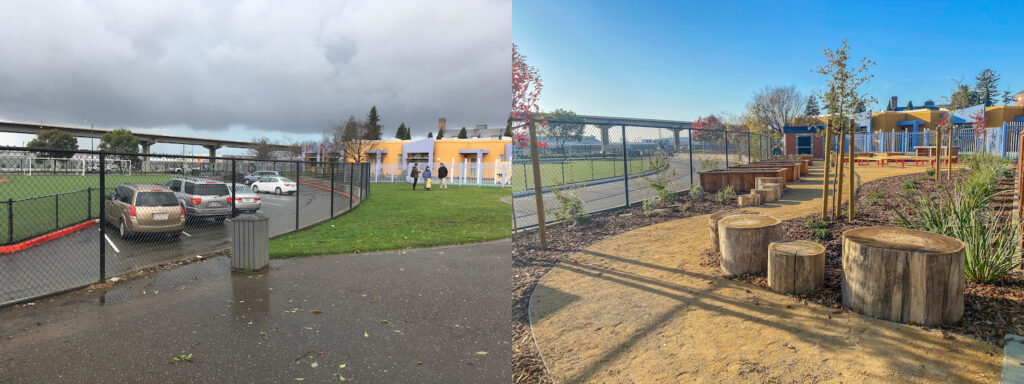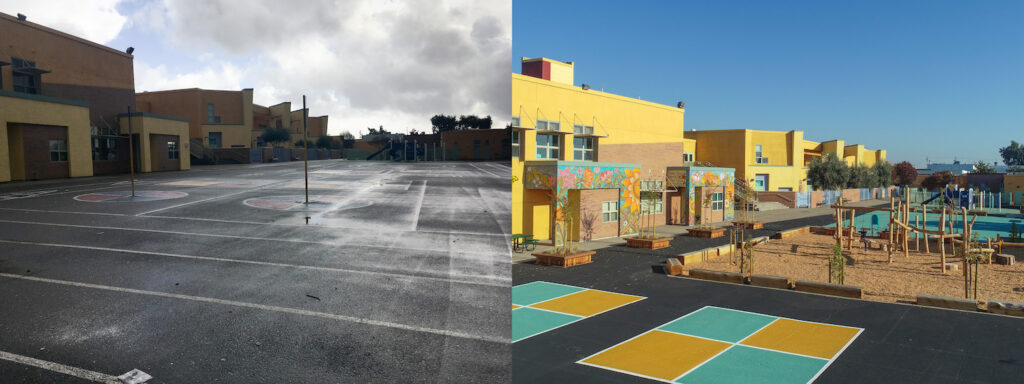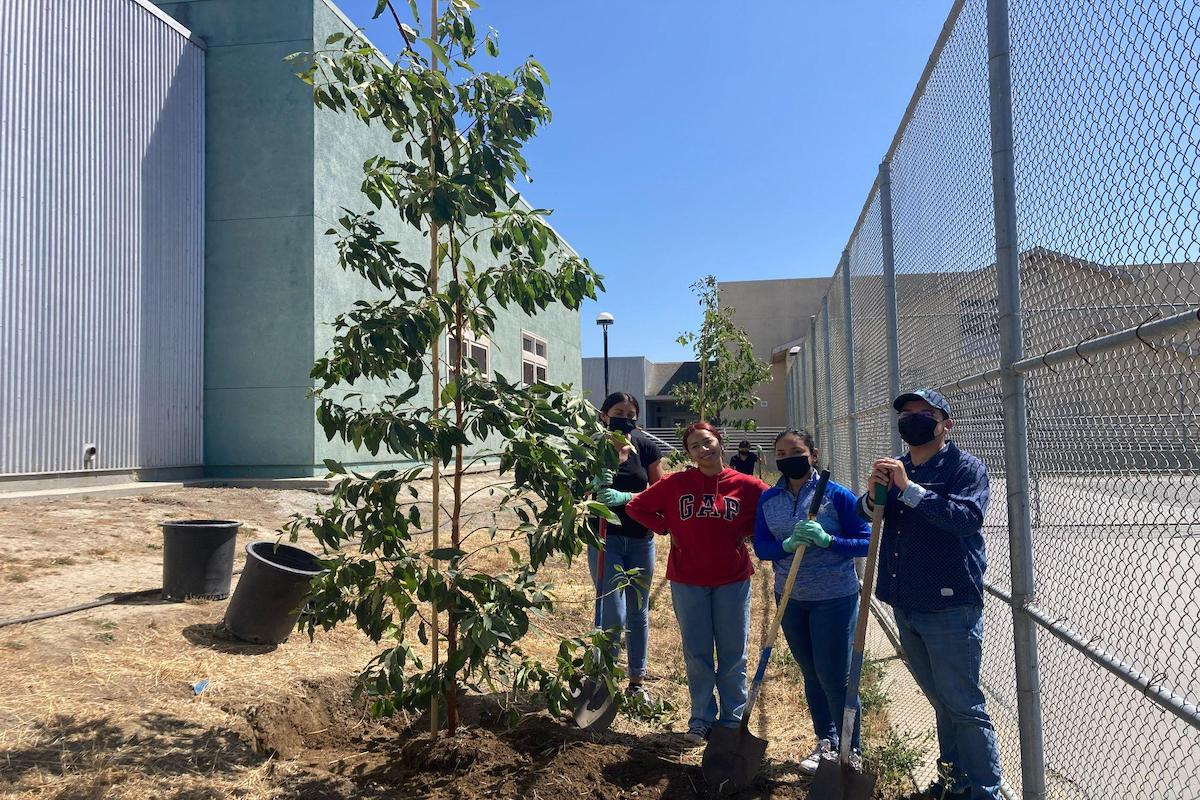Above: Climate Corps Leadership Institute students from Watsonville Wetlands Watch (WWW) planting a tree on the Pajaro Valley High School campus. WWW was among the 15 organizations to receive the $47 million first round of CalFIRE’s Green Schoolyard Grant program to shade kids by replacing school pavement with drought-tolerant green space.
As extreme heat scorches California, schools preparing to reopen across the Bay Area are also preparing to use the first $47 million of a new $117 million CalFIRE program to shade kids by replacing school pavement with drought-tolerant green space.
15 projects for 100 schools statewide were selected on July 12 to receive this first round of Green Schoolyard Grants, including those in the Oakland and San Francisco Unified School Districts, and the Santa Clara County Office of Education. At least 70% of the $117 million will green schools in low-income and disadvantaged communities, which are shown in studies to be as much as 7 degrees Fahrenheit hotter in summer than wealthier areas nearby.
The program is part of Gov. Gavin Newsom’s historic $800 million Extreme Heat Action Plan. As part of the plan, Newsom also launched Heat Ready CA this month. This is a 2-year, $20 million public outreach campaign, with resources available on HeatReadyCA.com, which will guide the state’s response to heat waves by focusing upon vulnerable populations including older adults, frontline workers, those with chronic illness and those who are pregnant.
Children among most vulnerable to extreme heat

Among the most vulnerable are children, whom researchers warn are significantly more susceptible to heat waves than adults. Extreme heat, the deadliest weather event in the country, is consistently linked to more children’s hospital visits nationwide.
In California, 5.9 million K-12 children attend public schools on about 130,000 acres of land. Alejandra Chiesa, California state director of asphalt conversion at the nonprofit Green Schoolyards America, said in a statement the fact that “much of this land is paved and unshaded leaves vulnerable students across the state exposed to extreme heat.”
In school districts across the Bay Area, maximum summer temperatures are expected to rise as much as 7.4 degrees Fahrenheit by midcentury, according to state climate projections.
In 90-degree weather, schoolyard surfaces like asphalt — which absorbs up to 90 percent of solar radiation — can be hot enough to cause third-degree burns, while plant-shaded surfaces may be 20 to 45 degrees cooler.
More trees, cooler temps
Kira Maritano, senior program manager of the Trust for Public Land (TPL), which won a grant to green 15 schools in the Oakland Unified School District (OUSD), said “Many campuses in Oakland are effectively large swaths of asphalt with very limited tree canopy, often in neighborhoods which are themselves park-poor. By increasing the environmental health of schools, we increase it throughout Oakland.”
This Green Schoolyard project, for example, “benefits the Bay and eases the impact on our utility system by absorbing stormwater, it creates habitats for native animals and pollinators, and it helps connect children to nature by giving them direct access. Play spaces with native plants allow more diverse activities than just competitive sports. Schoolyards become community areas for families to gather, and give teachers opportunities for outside, hands-on learning,” she explained.
TPL’s schoolyard work over the past six years, particularly the renovation of OUSD’s Cesar E. Chavez campus in 2020, has been praised as a model of climate resiliency by state leaders like First Partner Jennifer Siebel Newsom and Natural Resources Secretary Wade Crowfoot. Cesar E. Chavez, in the Fruitvale neighborhood of Oakland, serves 628 students across two elementary schools — International Community School and Think College Now. In 2020, TPL and OUSD transformed the school’s 90% asphalt yard into a green oasis including a vegetable garden, grass field, an outdoor classroom and tree-lined basketball courts.
“We believe that Oakland’s early adoption of schoolyard greening helped inspire the state to invest in it, and we see this investment as just the beginning,” Maritano said. “TPL is currently working to secure an additional $1 billion for greening schools statewide through a proposed school bond. Schools are in almost every community across California, and they’re an underutilized way to bring heat relief to these communities.”

Schools bake under rising heat
Jennifer Mutch, science coordinator for the Santa Clara County Office of Education (SCCOE), said that as record-melting temperatures climb statewide and schools prepare to reopen, it’s often forgotten that children are even more vulnerable to heat-related illness than adults.
Mutch, who won a Green Schoolyard Grant for SCCOE’s Sunol Community School and Opportunity Youth Academy campuses, added “trees and shrubs to be planted at these sites will not only cool temperatures but improve air quality and even mental health,” given that students facing extreme heat are not only “unable to get outside for recess or lunch” but perform significantly worse at exams, which impacts high school graduation rates.
Despite these impacts, she said, schools often have some of the hottest sites in their communities, “especially in the event of power and air conditioning outages.”
The full effect of these factors upon students is unknown, because California does not require schools to have heat interventions like air conditioning, shaded schoolyards or indoor temperature requirements, nor does it track which schools implement them.
Brian Lee, Community Development Director of Covina, California — which won a grant with Charter Oak Unified School District to green a four-acre recreational field at Royal Oak Middle School — said, “When districts face hard choices about how to spend limited budgets, of course they’ll prioritize the education itself. However, this doesn’t leave as much for updating and maintaining the facilities where students are taught, and that can negatively impact the quality of this education.”
New climate focused career paths
These impacts spread well beyond schools, and the mitigation lasts well after planting. The grounds at Royal Oak are heavily used by the entire community, Lee said. “Every day and after dark you see youth soccer or softball, but also adults playing basketball, jogging, walking their dogs, and the heat affects them all. Dirt can retain heat like asphalt, and we have such large expanses of both because what’s often overlooked is what comes after planting, the labor and money to irrigate grass and maintain trees.”
Jonathan Pilch, executive director of Watsonville Wetlands Watch (WWW), which received a grant to green four school campuses in the Pajaro Valley Unified School District, incorporates student help in maintaining trees on campuses.
“Tree maintenance is a long term challenge. We meet it by involving students in urban forestry not only as a way to build extreme heat resilience in schools, but as a lifelong career path. So far we’ve graduated 36 high school students thru our Climate Corps Leadership Institute, which has a yearlong urban forestry program.”
Watsonville, located in Santa Cruz County, has exceptionally low tree cover: 10% currently, and 8% when WWW started its urban forestry work in 2018. Throughout the city, Pilch said, “School campuses both have the lowest canopy cover” — often less than 5% — “and gain the most from tree equity, for both environmental and student health.”
WWW will develop its plans by holding in-class and extracurricular workshops with students, parents, teachers, engineers and landscape architects across all four schools over the next year. Forestation will target the hottest and least-covered parts of each site, such as tree-lined borders and walkways that improve campus air quality.
“The most effective way to help an environment is to help those living in it at the same time,” said Pilch. “This grant is crucial not only because it lets us plant schoolyards; that’s the beginning. Trees are deep-rooted and slow-growing. It also lets us think about these spaces as living schoolyards, and about how maintaining them can transform every aspect of a learning environment in the long run.”




